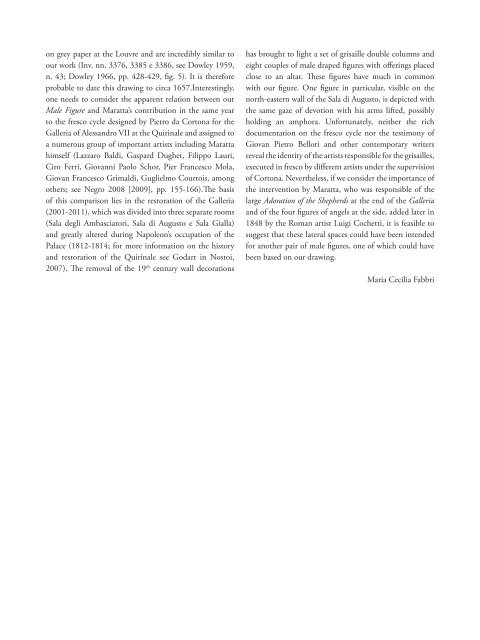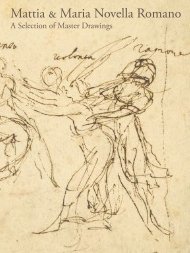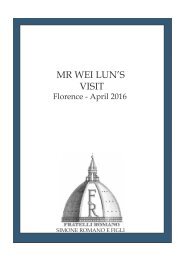A Selection of master drawings 2014
- No tags were found...
You also want an ePaper? Increase the reach of your titles
YUMPU automatically turns print PDFs into web optimized ePapers that Google loves.
on grey paper at the Louvre and are incredibly similar to<br />
our work (Inv. nn. 3376, 3385 e 3386, see Dowley 1959,<br />
n. 43; Dowley 1966, pp. 428-429, fig. 5). It is therefore<br />
probable to date this drawing to circa 1657.Interestingly,<br />
one needs to consider the apparent relation between our<br />
Male Figure and Maratta’s contribution in the same year<br />
to the fresco cycle designed by Pietro da Cortona for the<br />
Galleria <strong>of</strong> Alessandro VII at the Quirinale and assigned to<br />
a numerous group <strong>of</strong> important artists including Maratta<br />
himself (Lazzaro Baldi, Gaspard Dughet, Filippo Lauri,<br />
Ciro Ferri, Giovanni Paolo Schor, Pier Francesco Mola,<br />
Giovan Francesco Grimaldi, Guglielmo Courtois, among<br />
others; see Negro 2008 [2009], pp. 155-166).The basis<br />
<strong>of</strong> this comparison lies in the restoration <strong>of</strong> the Galleria<br />
(2001-2011), which was divided into three separate rooms<br />
(Sala degli Ambasciatori, Sala di Augusto e Sala Gialla)<br />
and greatly altered during Napoleon’s occupation <strong>of</strong> the<br />
Palace (1812-1814; for more information on the history<br />
and restoration <strong>of</strong> the Quirinale see Godart in Nostoi,<br />
2007). The removal <strong>of</strong> the 19 th century wall decorations<br />
has brought to light a set <strong>of</strong> grisaille double columns and<br />
eight couples <strong>of</strong> male draped figures with <strong>of</strong>ferings placed<br />
close to an altar. These figures have much in common<br />
with our figure. One figure in particular, visible on the<br />
north-eastern wall <strong>of</strong> the Sala di Augusto, is depicted with<br />
the same gaze <strong>of</strong> devotion with his arms lifted, possibly<br />
holding an amphora. Unfortunately, neither the rich<br />
documentation on the fresco cycle nor the testimony <strong>of</strong><br />
Giovan Pietro Bellori and other contemporary writers<br />
reveal the identity <strong>of</strong> the artists responsible for the grisailles,<br />
executed in fresco by different artists under the supervision<br />
<strong>of</strong> Cortona. Nevertheless, if we consider the importance <strong>of</strong><br />
the intervention by Maratta, who was responsible <strong>of</strong> the<br />
large Adoration <strong>of</strong> the Shepherds at the end <strong>of</strong> the Galleria<br />
and <strong>of</strong> the four figures <strong>of</strong> angels at the side, added later in<br />
1848 by the Roman artist Luigi Cochetti, it is feasible to<br />
suggest that these lateral spaces could have been intended<br />
for another pair <strong>of</strong> male figures, one <strong>of</strong> which could have<br />
been based on our drawing.<br />
Maria Cecilia Fabbri





